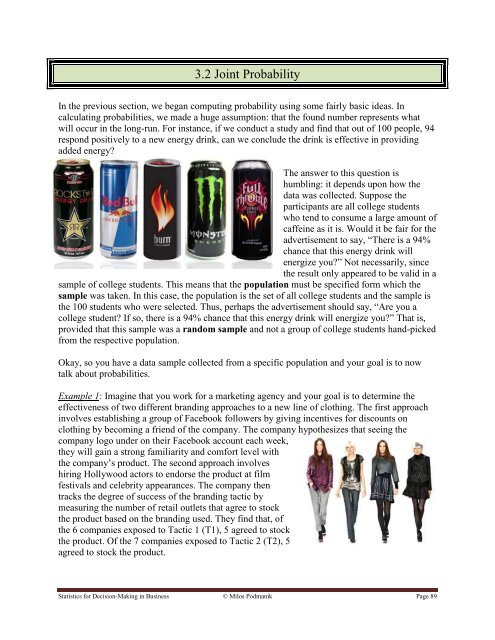Statistics for Decision- Making in Business - Maricopa Community ...
Statistics for Decision- Making in Business - Maricopa Community ...
Statistics for Decision- Making in Business - Maricopa Community ...
You also want an ePaper? Increase the reach of your titles
YUMPU automatically turns print PDFs into web optimized ePapers that Google loves.
3.2 Jo<strong>in</strong>t Probability<br />
In the previous section, we began comput<strong>in</strong>g probability us<strong>in</strong>g some fairly basic ideas. In<br />
calculat<strong>in</strong>g probabilities, we made a huge assumption: that the found number represents what<br />
will occur <strong>in</strong> the long-run. For <strong>in</strong>stance, if we conduct a study and f<strong>in</strong>d that out of 100 people, 94<br />
respond positively to a new energy dr<strong>in</strong>k, can we conclude the dr<strong>in</strong>k is effective <strong>in</strong> provid<strong>in</strong>g<br />
added energy<br />
The answer to this question is<br />
humbl<strong>in</strong>g: it depends upon how the<br />
data was collected. Suppose the<br />
participants are all college students<br />
who tend to consume a large amount of<br />
caffe<strong>in</strong>e as it is. Would it be fair <strong>for</strong> the<br />
advertisement to say, “There is a 94%<br />
chance that this energy dr<strong>in</strong>k will<br />
energize you” Not necessarily, s<strong>in</strong>ce<br />
the result only appeared to be valid <strong>in</strong> a<br />
sample of college students. This means that the population must be specified <strong>for</strong>m which the<br />
sample was taken. In this case, the population is the set of all college students and the sample is<br />
the 100 students who were selected. Thus, perhaps the advertisement should say, “Are you a<br />
college student If so, there is a 94% chance that this energy dr<strong>in</strong>k will energize you” That is,<br />
provided that this sample was a random sample and not a group of college students hand-picked<br />
from the respective population.<br />
Okay, so you have a data sample collected from a specific population and your goal is to now<br />
talk about probabilities.<br />
Example 1: Imag<strong>in</strong>e that you work <strong>for</strong> a market<strong>in</strong>g agency and your goal is to determ<strong>in</strong>e the<br />
effectiveness of two different brand<strong>in</strong>g approaches to a new l<strong>in</strong>e of cloth<strong>in</strong>g. The first approach<br />
<strong>in</strong>volves establish<strong>in</strong>g a group of Facebook followers by giv<strong>in</strong>g <strong>in</strong>centives <strong>for</strong> discounts on<br />
cloth<strong>in</strong>g by becom<strong>in</strong>g a friend of the company. The company hypothesizes that see<strong>in</strong>g the<br />
company logo under on their Facebook account each week,<br />
they will ga<strong>in</strong> a strong familiarity and com<strong>for</strong>t level with<br />
the company‟s product. The second approach <strong>in</strong>volves<br />
hir<strong>in</strong>g Hollywood actors to endorse the product at film<br />
festivals and celebrity appearances. The company then<br />
tracks the degree of success of the brand<strong>in</strong>g tactic by<br />
measur<strong>in</strong>g the number of retail outlets that agree to stock<br />
the product based on the brand<strong>in</strong>g used. They f<strong>in</strong>d that, of<br />
the 6 companies exposed to Tactic 1 (T1), 5 agreed to stock<br />
the product. Of the 7 companies exposed to Tactic 2 (T2), 5<br />
agreed to stock the product.<br />
<strong>Statistics</strong> <strong>for</strong> <strong>Decision</strong>-<strong>Mak<strong>in</strong>g</strong> <strong>in</strong> Bus<strong>in</strong>ess © Milos Podmanik Page 89
















